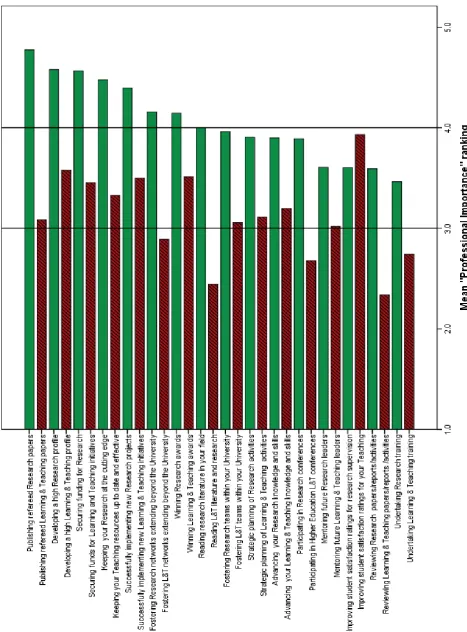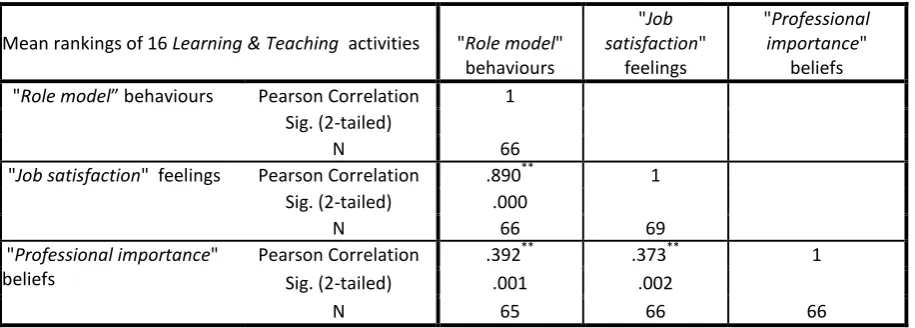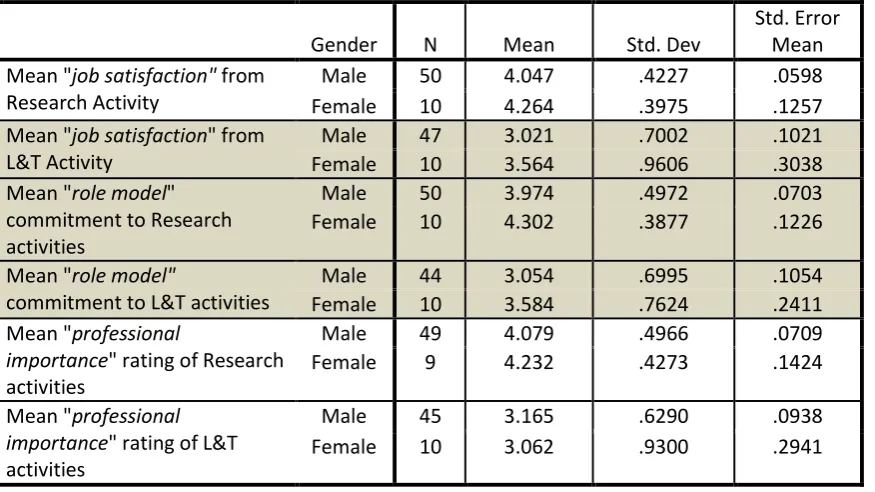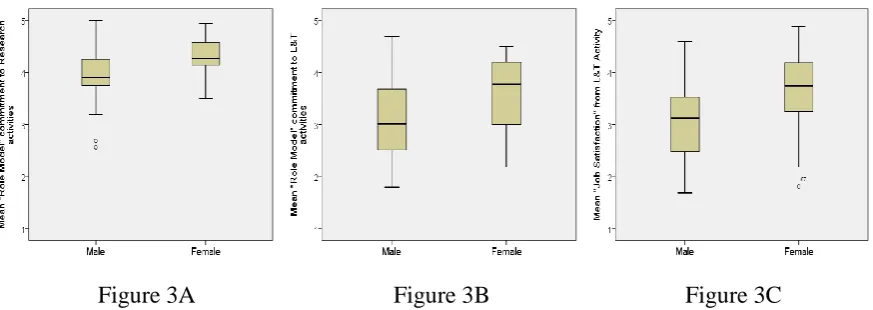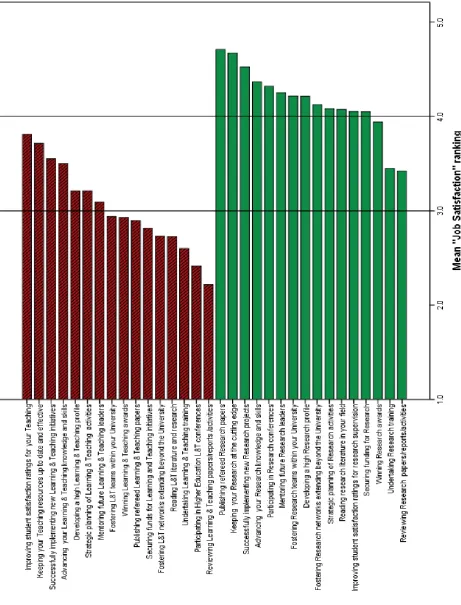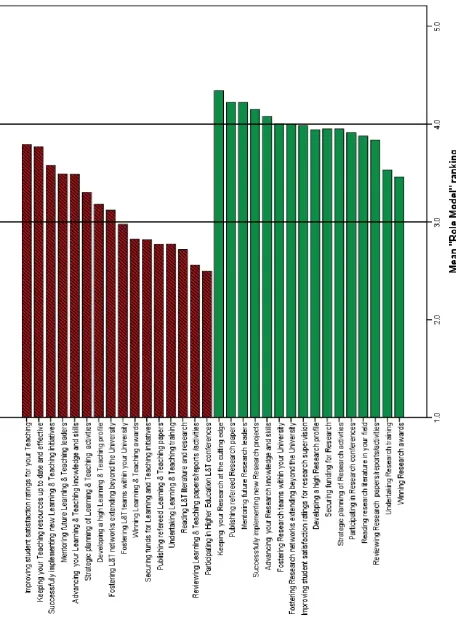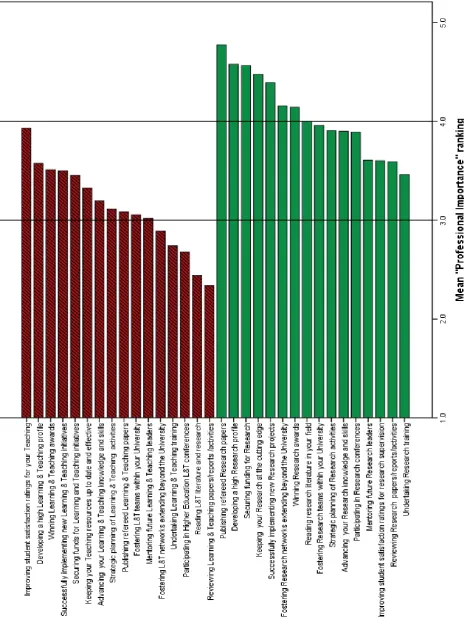This may be the author’s version of a work that was submitted/accepted for publication in the following source:
Cretchley, Patricia, Edwards, Sylvia, O’Shea, Peter, Sheard, Judithe, Hurst, John, & Brookes, Wayne
(2014)
Research and/or learning and teaching: a study of Australian professors’ priorities, beliefs and behaviours.
Higher Education Research and Development,33(4), pp. 649-669. This file was downloaded from: https://eprints.qut.edu.au/66351/
c
Consult author(s) regarding copyright matters
This work is covered by copyright. Unless the document is being made available under a Creative Commons Licence, you must assume that re-use is limited to personal use and that permission from the copyright owner must be obtained for all other uses. If the docu-ment is available under a Creative Commons License (or other specified license) then refer to the Licence for details of permitted re-use. It is a condition of access that users recog-nise and abide by the legal requirements associated with these rights. If you believe that this work infringes copyright please provide details by email to qut.copyright@qut.edu.au
Notice:Please note that this document may not be the Version of Record (i.e. published version) of the work. Author manuscript versions (as Sub-mitted for peer review or as Accepted for publication after peer review) can be identified by an absence of publisher branding and/or typeset appear-ance. If there is any doubt, please refer to the published source.
1
Research and/or Learning & Teaching: A study of Australian professors’
priorities, beliefs and behaviours
a
P.C. Cretchley*,
aS.L. Edwards*,
aP. O’Shea,
cJ. Sheard,
cJ. Hurst,
dW.
Brookes
a
Science & Engineering Faculty, Queensland University of Technology, Brisbane, Australia; c
Faculty of Information Technology, Monash University, Melbourne, Australia;
d
Faculty of Engineering & Information Technology, University of Technology, Sydney, Australia.
This paper presents findings from an empirical study of key aspects of the teaching and research priorities, beliefs and behaviours of 72 professorial and associate professorial academics in Science, Information Technology and Engineering across four faculties in three Australian universities. The academics ranked sixteen Research activities and sixteen matched Learning & Teaching (L&T) activities from three perspectives: job satisfaction, role model behaviour, and perceptions of professional importance. The findings were unequivocally in favour of Research in all three areas, and remarkably consistent across the universities. The only L&T activity that was ranked consistently well was “Improving student satisfaction ratings for Teaching”, an area in which academics are increasingly held accountable. Respondents also indicated that their seniors encourage Research efforts more than L&T efforts. Recommendations include that Higher Education rewards for quality Learning & Teaching are maintained or improved, and that recognition of L&T research domains is further strengthened.
* Corresponding authors:
2
Research and/or Learning & Teaching: A study of Australian professors’ beliefs, behaviours and priorities
This paper presents findings from an empirical study of key aspects of the teaching and research priorities, beliefs and behaviours of 72 professorial and associate professorial academics in Science, Information Technology and Engineering across four faculties in three Australian universities. The academics ranked sixteen Research activities and sixteen matched Learning & Teaching (L&T) activities from three perspectives: job satisfaction, role model behaviour, and perceptions of professional importance. The findings were unequivocally in favour of Research in all three areas, and remarkably consistent across the universities. The only L&T activity that was ranked consistently well was “Improving student satisfaction ratings for Teaching”, an area in which academics are increasingly held accountable. Respondents also indicated that their seniors encourage Research efforts more than L&T efforts. Recommendations include that Higher Education rewards for quality Learning & Teaching are maintained or improved, and that recognition of L&T research domains is further strengthened.
Keywords: Australian universities; learning and teaching; professional culture; research-teaching nexus
Subject classification codes: 130103, 130304.
Introduction:
The research-teaching nexus: a myth or a reality? Good examples from this paradigm can be seen in personalities such as Julius Sumner Milner and Karl Kruszelnicki. Their popularity owes much to their engagement with the learning community, and their ability to transfer their own thirst for knowledge to the student. These types of higher education leaders are rare, and according to Scott, Coates & Anderson, “Australia is facing [a] significant higher education leadership succession challenge”(Scott, Coates & Anderson, 2008).
This paper reports on preliminary work from a project seeking to strategically address this leadership need. The project sought to build a changed culture in three Australian universities, where the professoriate lead effectively, not just in research but also in learning & teaching (L&T). The study was positioned within the disciplines of Information and Communication Technology (ICT) and Engineering. To determine whether the broader project objectives were achieved, at the commencement of the study we surveyed each universities academic staff beliefs, behaviours and priorities for research and L&T. The findings were unequivocally in favour of research in all three areas, and remarkably consistent across the three universities.
This paper will first report on the key themes and outcomes of prior research into the research-teaching nexus; then outline the results of the commencement survey.
Research-Teaching Nexus:
3
Motivating the research goals set by university administrators are clear financial rewards and professional status for both researcher and institution. In contrast, the rewards for those who deliver heightened teaching performance have been less evident, and this differentiation has implications for the ways in which academics commit their time. Not all academics regard teaching and research as integrated (Fox, 1992). For example, Light’s (Light, 1974) perspective was that research and teaching were in constant tension, Ladd (Ladd Jr, 1979) claimed that they were at odds, and Clark and Salomon (Clark & Salomon, 1986) held the view that the two are characterised by an uneasy division of labour. Investigating what she termed the “mutuality” versus the “competition” of research and teaching in academia, Fox compiled data from 2738 social science academics in the USA with this data pointing to a “strain between teaching and research” that is contrary to the mutuality perspective (Fox, 1992, p. 293). This substantial data was captured from respondents comprising 69% of a random sample of 3,968 academics in the social sciences.
Clark (Clark, 1997), Colbeck (Colbeck, 1998) and others have expressed concern that many university administrators and academics believe that attaining research and teaching goals requires academics to engage in separate and distinct activities. Clark (1997) argued from cross-national US interviews with college and university teachers, that academics merge the two seamlessly. However, Colbeck’s (1998) findings indicated that academics manage their research and teaching in different ways, and that the nature of their research areas plays a key role in how closely they can and do integrate teaching and research. Only some integrated their work quite seamlessly. Others focused on one at the expense of the other. Those working in the so-called “hard” disciplines (Physics, for example) were more likely to be engaged in research with their colleagues and students, and adopt master-apprentice models than those in the “soft” disciplines (for example, languages). Smeby’s (Smeby, 1998) data also revealed discipline differences. At the undergraduate level academics in the humanities and the social sciences reported stronger research-teaching interactions than academics in other fields. At the graduate level, no discipline differences were apparent, but the interactions between research and teaching were much stronger, with research more influential on teaching and more important for teaching than vice versa. These findings confirm that academics integrate or separate their teaching and research roles differently across disciplines and context.
4
described the nexus as having a collective departmental research base that provides direction, framework and resources for the courses offered to students, as well as a tangible teaching component, where teaching disseminates research skills and knowledge. It also has an intangible component, where teaching facilitates the development of critical thinking and positive attitudes to research in students.
Surveying dominant conceptualizations of the research-teaching nexus, McLean and Barker (McLean & Barker, 2004) pointed to two key perspectives: one that emphasises the mutual benefit to researchers and students in building knowledge and meaning, and one targeting the development of students’ research capacity through the curriculum. Incorporating these elements, Healey & Jenkins (Healey & Jenkins, 2006) offered a broad four-quadrant model of the research-teaching nexus, which has also been used by Willcoxson, Manning, Johnston and Gething (Willcoxson, Manning, Johnston & Gething, 2011).
Some researchers have reviewed models of relationships between university research and teaching. Based on a meta-analysis of 58 studies, Hattie and Marsh (Hattie & Marsh, 1996) questioned why beliefs in the “myth” of their complementarities persist (Hattie & Marsh, 1996, p. 533), and concluded that research and teaching are not related in contemporary universities. Arguing that teaching-only tracks were ill-advised because they have segregating effects, they suggested universities should target the improvement of the nexus between research and teaching, proposing specific strategies that may be helpful:
emphasize the construction of knowledge rather than impart knowledge; increasing the circumstances in which teaching and research meet; ensure that the best researchers teach at all levels;
ensure that students experience the process of artistic and scientific productivity; reward those who demonstrate the integration of their research and teaching; reward teachers for critically reviewing curricula and teaching current material; ensure that teaching brings job rewards equal to publication in promotion and
application.
This range of conceptualisations of the research-teaching nexus, and these findings, offer understandings of the different ways in which academics perceive the tensions between research and teaching, the relationships between them, and opportunities to exploit the latter in academia. However, the literature offers little on how academics perceive their relative roles, behaviours and commitments in comparable types of research and teaching activity.
Academic Life Rewards:
5
Among those universities that have established teaching excellence awards, and a commitment to teaching, are many of the liberal arts institutions in the US. Investigating what it is that such awards try to measure, Chism (2006, p. 589) noted that while they are coveted by some in institutions, they can sometimes be a “kiss of death” for professional progress in research institutions. This contributes to warnings in the literature that teaching awards do not always achieve their goals.
Without deliberate efforts to showcase the exemplary practices of strong teachers, however, the examples set by exceptional teachers may not contribute to the wider improvement of university teaching. Certainly Halse et al.’s (Halse, Deane, Hobson & Jones, 2007) study of twenty-nine outstanding teachers indicated that they were generally active researchers in their disciplines, and unlikely to publish about their teaching or about improving teaching practice. These and other examples from the literature suggest that balancing teaching and research remains a personal issue for individual academics in many universities, and that the research-teaching nexus is tantalisingly complex.
Certainly questions remain for university management. Like other researchers, Halse et al. (p. 727) warn that their findings have “policy implications for the separation of teaching and research within and between universities”, and caution university managers and policy makers against making “pre-emptive decisions about the relationship between teaching and research based on questionable assumptions”.
Aleadership succession crisis?
Scott, Coates and Anderson’s (Scott et al., 2008) investigation of academic leadership led them to conclude that many Australian universities are confronted by a leadership succession crisis as a result of change pressures that stem from broader societal forces of change, and - in decreasing rank order - decreased government funding, pressure to generate new income, balancing work and family life, managing the pressures for continuous change, having to deal with slow and unresponsive administrative processes, finding and retaining high-quality staff, and increased government reporting and scrutiny. These pressures are testing the extent to which institutions and their leaders are change capable. Management of research and teaching are perceived to be different. In particular, academics perceive that the capacities needed for leadership of research and for teaching are different, that “leaders of research have a much more precise role compared with learning and teaching leaders”. Some of their comments on the differences include (Scott, et al., 2008, p. 5):
Research and teaching require different skills. How you become a research leader is quite different from how you become a “learning and teaching” leader.
The outcomes of the research effort are more bounded, agreed and defined— measurement of research outcomes is clearer.
6
These findings point not just to different leadership skills in the two areas, research and L&T, but to the importance of up-to-date knowledge in both fields. Indeed, Scott et al.’s study concluded that effective university leadership hinges on “high level of up-to-date knowledge about effective learning and teaching in higher education” (Scott, et al., 2998, p. 26), alongside knowledge about how universities function and efficient organisational strategies. This imperative raises the question of the importance of senior academics having high level knowledge about effective L&T in higher education. Are future academic leaders engaging in discourse about higher education beyond their own teaching? And if not, how can substantial engagement in such discourse and in creative thinking be encouraged?
The next section outlines recent national and institutional Australian initiates to raise levels of consideration of key issues in modern university education and to facilitate quality teaching in Australian universities.
The Australian Context:
Changes in the nature of the demand for higher education in Australia, competition between universities, and funding models based on student enrolment and progression rates, have stimulated the introduction of new initiatives to raise the quality of university teaching over the last decade. In 2003, the Australian Federal Government announced a National Teaching and Learning Performance Fund that rewards universities competitively on their annual teaching performance. In parallel, the Australian Learning and Teaching Council implemented an enhanced suite of national Learning and Teaching awards, fellowships and grants to reward and disseminate exemplary teaching practices and to support promising new initiatives. These incentives fuelled efforts by some university managers to raise teaching quality and reward teaching effort, with many Australian university schools and faculties establishing Associate Deanships to specifically target L&T issues. Many also expanded (or mirrored) their institutional L&T scheme incentives.
To support the changes, Australian universities also implemented more frequent and compulsory student evaluation of teachers and courses. The goals extend beyond identifying areas of teaching strength and weakness in order to raise pass or retention rates, with universities making public information on levels of student satisfaction with their university learning experiences. Most universities made the student scores and comments available to Deans and Supervisors (and possibly others), and increasingly require this data for assessment of performance and promotion. Aggregated data from students’ responses to a national Course Experience Questionnaire (CEQ: Course Experience Questionnaire Overview, 2012) on completion of their degree program are now available nationally, and the institutional CEQ data contribute to the criteria used to determine each university’s share of the National Teaching and Learning Performance Fund.
7
On a national basis, most of the drivers of university education quality mentioned earlier will be replaced by Tertiary Education Quality and Standards Agency (TEQSA, 2013) and the new Australian University mission based Compacts (DIISRTE, 2011). The intention has been to make Australian tertiary education quality standards publicly visible from 2012 onwards, and with the MyUniversity website (http://myuniversity.gov.au/), this transparency is likely to increase. While the quality measures that will be used are yet to be finalised, at the time of writing this paper, data sets such as the CEQ and the Excellence of Research in Australia rankings (ERA, 2012), or equivalent, are likely to be included, plus a new survey instrument that is based on the AUSSE (Australasian Survey of Student Engagement) instrument (ACER, 2011). Having these tertiary institution datasets in the public domain will be an incentive for Australian universities to continue efforts to improve both research and L&T performance.
Questions arise, however, about the extent to which these national and institutional measures will target the key quality issues surrounding higher education and university learning, and the effects of the emphasis on these types of evaluations as measures of research and teaching performance. Only time will tell us if these initiatives will impact academics’ perceptions of the importance of teaching compared to research, and whether they will raise levels of commitment by academics to L&T activity and performance.
When we consider the disciplines of this reported study, ICT and Engineering, a number of trends are evident. Although demand for ICT courses is increasing at the time of writing this paper, ICT faculties experienced an unprecedented downturn in student numbers from 2003, despite strong employer demand (ACS, 2008), and the ICT higher education sector in Australia experienced significant redundancies. Similarly, the Engineering sector had failed to attract enough students to meet employer demand (TAD, 2005).
Historically, ICT and Engineering disciplines have also received low CEQ scores from their graduates, compared to other disciplines (Ainley, 2000). Leadership Competency in L&T has also been shown to be particularly low in ICT and Engineering (Scott et al., 2008). These disciplines are therefore critically aware of the need for action and ripe for cultural change.
Given these trends, an initiative was undertaken across three Australian universities to engage senior ICT and Engineering academics to reflect on their teaching and research leadership roles and responsibilities, and to provoke higher levels of discussion in leadership on the issues faced by university teachers. Professorial academics were targeted in particular, since they constitute the university leaders of the near future.
To establish what types of activities teaching and research activities attract the personal and professional interest of senior academics, this initiative included an investigation of
i) perceptions of the relative importance of a range of teaching and research activities,
ii) the areas to which academics commit leadership and effort, and
iii) the factors that drive academics decisions with respect to research and teaching investment.
The Aims and Design of the Study
:
8
were targeted: job satisfaction, leader role model behaviour, and perceptions of professional importance. Items were developed to describe sixteen research matched activities and sixteen matched teaching activities. Examples of the matched items are as follows:
Keeping your Research at the cutting edge
Keeping your Teaching resources up to date and effective Advancing your Research knowledge
Advancing your L&T knowledge
Improving student satisfaction ratings for your Research supervision Improving student satisfaction ratings for your Teaching
Respondents were invited to rate each of the thirty-two items from each of the following three perspectives:
A. To what extent do you gain personal job satisfaction from each of the following? B. To what extent do you try to be a role model for each of the following?
C. How important are the following for advancement in the academic profession?
Likert-style responses were invited on a continuum from 1 to 5, where 1 indicated a low level of satisfaction, commitment or importance, 3 a medium level, and 5 a high level.
The questionnaire also included matched open questions inviting academics to comment on the degree to which research efforts and L&T efforts were encouraged and supported by their seniors. Demographic information on gender, age, professional level, area of research focus, and leadership responsibilities was requested, but was voluntary, to protect anonymity.
The data capture and the demographics of the respondents:
The universities targeted for the surveys are major urban institutions in three Australian states. University A is well established, with a long tradition of Research. Universities B and C are newer universities currently successfully building their research profiles. The academics were professors and associate professors in the STEM disciplines of Science, Technology, Engineering and Mathematics.
The surveys were administered at faculty-wide workshops for the professoriate. Seventy-two academics responded, 15 from University A, 14 from University B, and 43 from University C. Not all the demographic information was provided by these academics, but most offered a substantial amount. Their academic leadership responsibilities encompassed a wide spread of roles, from course coordination, discipline leadership, and to Faculty leadership. Eleven respondents declared L&T to be their primary research area. The others named a wide range of discipline areas.
The sample was evenly spread across the professorial and associate professorial levels (32 and 31 respectively). Males dominated in the ratio of 5 to 1 (50 males, 10 females). Half of the respondents were in the middle age-group (46 to 55 years), twelve were younger (36-45), and twenty-two older (over 56). A typical member of this professoriate was a male aged 46 to 55.
Analysis and Findings:
9
Sample sizes are not even, but the ratings were remarkably consistent across the three universities. Figures 1 A, B and C show the mean ratings for each set of sixteen activities for each university, grouped in matched pairs. The consistency in the Research means is clear across the three higher bars, and the consistency in the L&T means is visible across the three lower bars. MANOVA tests confirmed no statistically significant differences in the mean ratings of any of the six sets across the three groups. That is, none of the values for Pillai’s Trace, Wilks’ Lambda, Hotelling’s trace, Roy’s largest Root (generated by SPSS) were significant. The consistency of these datasets across the three universities supported the use of the aggregated data for the group in the further analysis.
A: Job satisfaction B: Role model behaviour C: Professional importance
Figure 1: Bar-graphs showing the similarity in rankings of job satisfaction, role model behaviour and professional importance for Research and L&T activity across the universities.
Overall findings on professional feelings, behaviours and beliefs:
Using the collective data for the three universities (N=72), the group mean response was calculated for six sets of sixteen activities: one set for Research and one set for L&T, for each of the three questions labelled A, B and C above.
Substantial differences between the Research means and the L&T means are evident in Figure 2 A, B and C, which shows the mean responses in matched item pairs.
10
Figure 2A: Mean rankings of matched pairs of activities from the perspective of job
11
12
13
For each of the three questions, paired sample t-tests on the means across each set of items indicated that the Research mean was significantly higher than the L&T mean (p<.001). Hence the professoriate from four faculties in three universities unequivocally indicated the following:
that they gained far higher job satisfaction from Research activities than from L&T activities;
that they committed far more effort to being role models for Research activities than they do to L&T activities;
that they perceived Research activities to be of greater importance, professionally, than L&T activities.
Correlation data confirmed that Research and Teaching occupy very different dimensions for these academics. That is, there were no significant correlations between these academics’ overall Research and L&T ratings. Nor were there any significant correlations between their job satisfaction scores for these two areas, or between their role model behaviour scores, or between their scores for beliefs about professional importance.
Table 1A: Correlations between Research behaviours, feelings and beliefs.
Mean rankings of 16 Research activities "Role model"
behaviours
"Job satisfaction"
feelings
"Professional importance" beliefs "Role model” behaviours Pearson Correlation 1
Sig. (2-tailed)
N 72
"Job satisfaction" feelings
Pearson Correlation .507** 1
Sig. (2-tailed) .000
N 72 72
"Professional importance" beliefs
Pearson Correlation .534** .478** 1
Sig. (2-tailed) .000 .000
N 70 70 70
** Significant at the .01 level
Table 1B: Correlations between Learning &Teaching behaviours, feelings and beliefs.
Mean rankings of 16 Learning & Teaching activities "Role model" behaviours "Job satisfaction" feelings "Professional importance" beliefs
"Role model” behaviours Pearson Correlation 1
Sig. (2-tailed)
N 66
"Job satisfaction" feelings Pearson Correlation .890** 1
Sig. (2-tailed) .000
N 66 69
"Professional importance" beliefs
Pearson Correlation .392** .373** 1
Sig. (2-tailed) .001 .002
N 65 66 66
14
For Research activity, there were consistent moderate positive Pearson correlation coefficients of around 0.5 (p<.01) between the job satisfaction gained, role model behaviour, and belief in professional importance: see Table 1A. For Teaching activity, role model behaviour was highly aligned with job satisfaction (r=0.9, p<.01), but far less aligned with belief in professional reward (r=0.4, p<.01): see Table 1B.
Findings for Academic Level, Age-group and Gender:
Academic Level: MANOVA multivariate tests found no significant differences between the mean Research rankings of the professorial academics and those of the associate professorial academics, for any of the six sets of items. This indicates the consistency of views in these areas across both levels of the professoriate.
Age group: The upper two age-groups were combined because of small sample sizes. MANOVA tests across the three age-groups revealed no significant differences in any of the six sets of items. Hence the younger professors had similar Research and L&T views, behaviours and feelings to their seniors. This suggests that the seniors may have been influential role models.
Gender: The shaded rows of Table 2 show that the 10 female academics had higher mean rankings than the 50 males in five of the six item groups, and substantially so in the three areas shaded, namely role model behaviour for both Research and L&T, and job satisfaction for L&T. MANOVA tests were unreliable because of the unequal sample sizes, the small size of the female sample, and the non-homogeneity of the co-variances (indicated by Box’s Test with p<.001). However, the box-plots of shown in Figure 3 A, B and C show substantial gender differences, females indicating higher job satisfaction from L&T Activity than males, and higher commitment to role model behaviours for both L&T and Research.
Table 2: Group means for each of the six sets of items, by Gender
Gender N Mean Std. Dev
Std. Error Mean Mean "job satisfaction" from
Research Activity
Male 50 4.047 .4227 .0598
Female 10 4.264 .3975 .1257
Mean "job satisfaction" from L&T Activity
Male 47 3.021 .7002 .1021
Female 10 3.564 .9606 .3038
Mean "role model" commitment to Research activities
Male 50 3.974 .4972 .0703
Female 10 4.302 .3877 .1226
Mean "role model"
commitment to L&T activities
Male 44 3.054 .6995 .1054
Female 10 3.584 .7624 .2411
Mean "professional
importance" rating of Research activities
Male 49 4.079 .4966 .0709
Female 9 4.232 .4273 .1424
Mean "professional importance" rating of L&T activities
Male 45 3.165 .6290 .0938
15
Figure 3A Figure 3B Figure 3C
Figure 3: Fig 3A and B show gender comparisons of role model behaviour for Research and for L&T, respectively. Figure 3C shows job satisfaction from L&T.
The only set of activities on which the 10 females indicated a lower mean overall than the males was regarding the professional importance of engaging in L& T activities.
The highest ranked Learning & Teaching activities:
Figure 2 A, B and C reveal that very few L&T activities rated above the lowest rated Research activities. Those that were rated higher than the two lowest-rated Research activities are noted below. In Appendix A, Figures 4 A, B and C show the same ratings as those in Figures 2, in decreasing order. The L&T activities rated highest for job satisfaction were as follows:
Improving student satisfaction ratings for your teaching Keeping your teaching resources up to date and effective Successfully implementing new learning & teaching initiatives Advancing your learning & teaching knowledge and skills
Those ranked highest for role model behaviour were similar: Improving student satisfaction ratings for your teaching Keeping your teaching resources up to date and effective Successfully implementing new learning & teaching initiatives
The activity ranked highest for professional importance was Improving student satisfaction ratings for your teaching
The dominant finding here is that the item “Improving student satisfaction ratings for your teaching” was ranked highly in all three areas. “Keeping your teaching resources up to date and effective” and “Successfully implementing new learning & teaching initiatives” were ranked next highest.
The lowest ranked Learning & Teaching activities:
16
The three ranked lowest for role model behaviour were similar: Participating in Higher Education L&T conferences Reviewing Learning & Teaching papers/reports/activities Reading L&T literature and research
The three ranked lowest for professional importance were also similar: Reviewing Learning & Teaching papers/reports/activities Reading L&T literature and research
Participating in Higher Education L&T conferences
These findings indicate that the professors perceive little need for publications and discourse in Higher Education.
Research activities:
Those ranked highest for job satisfaction were as follows: Publishing refereed research papers
Keeping your research at the cutting edge
Successfully implementing new research projects
Those ranked highest for role model behaviour were Keeping your research at the cutting edge Publishing refereed research papers Mentoring future research leaders
Those ranked highest for professional importance were Publishing refereed research papers
Developing a high research profile Securing funding for research
The high rankings of “cutting edge research” and “research publications” are consistent with the professional promotion incentives accorded these activities by universities. Similar observations apply to the other highly ranked items, for related activities.
The activities ranked lowest for job satisfaction were as follows: Reviewing research papers/reports/activities
Undertaking research training
Those ranked lowest for role model behaviour were Undertaking research training
Winning research awards
Those ranked lowest for professional importance were Undertaking research training
Reviewing research papers/reports/activities
Improving student satisfaction ratings for research supervision Mentoring future research leaders
17
by the professoriate of the importance of “mentoring future research leaders” is somewhat surprising.
Comparisons across matched items:
The significantly higher Research mean for each set of 16 items than L&T mean, in all three areas, has already been reported. For only one pair of matched items was the L&T ranking higher than the Research ranking: for “improving student satisfaction ratings” in the area of professional importance. This finding is consistent with the fact that student satisfaction ratings for teaching are increasingly required for annual performance reviews and in some universities also for promotion cases. Student ratings of the quality of research supervision are not used similarly. Research degree completions are used as indicators.
The matched pairs with the biggest differences in ranking (L&T much lower) were “conference attendance”, “publishing refereed papers”, and “engagement in reading the literature”. The low value these professors accord Higher Education as an area of research activity and academic discourse is clear.
Resourcing and encouragement:
Generally, these professorial staff regarded the resourcing of the Research and L&T activities to be about the same. At two of the three universities, they reported significantly higher levels of encouragement from their seniors, in favour of Research (t-tests, p<.05).
Summary and Conclusions
This paper presents the findings from an empirical study of the teaching and research priorities, beliefs and behaviours of 72 professorial and associate professorial academics in Science, Information Technology and Engineering across four faculties in three Australian universities. Their rankings of 16 research activities and 16 matched learning and teaching activities from each of three perspectives: job satisfaction, role model behaviour, and professional importance provide compelling evidence that these professors were consistently more heavily invested in research. The rankings were remarkably consistent across the three universities, across academic level (professor or associate professor), and across age-group, with the younger professors reflecting the views and behaviours of their seniors. There were few females, but they reported higher levels of role model behaviour in both Research and L&T, and higher feelings of satisfaction from L&T activity, generally, than the males.
Importantly, the rankings unequivocally favoured Research activities over L&T activities in each of these key professional areas, job satisfaction, role model behaviour and professional importance, the differences being generally significant. These academics had the highest regard for activities long honoured in academia, including familiarity with the research literature and participation in research conferences, but accorded the equivalent L&T activities low regard. The only L&T activity that ranked even just a little above the lowest Research activity was “Improving student satisfaction ratings for Teaching”, the area in which academics are most accountable for their L&T. They also invested some effort in keeping “teaching resources up to date and effective”. However, L&T activities like “developing a Learning & Teaching profile” and “winning L&T awards” were ranked very low.
18
professoriate was raising teaching scores, suggests that they are highly strategic, and invest effort in areas in which they are accountable. Their low regard for most L&T activity includes not highly valuing the literature and conference participation, This supports Halse, Deane, Hobson & Jones’s (2007) claims that most outstanding Australian university teachers publish in fields other than Higher Education, and suggests that universities do not greatly reward Higher Education discourse and research into L&T, and
The low relationships found between Teaching and Research activity do not mean that these academics would not or do not take opportunities to exploit research-teaching links to advance their students’ learning and research. They point to the fact that most of these senior academics have starkly different attitudes towards research and scholarly teaching-related activity.
These differences in attitude suggest that recent Australian government and university initiatives designed to reward teaching quality and commitment, do not yet appear to have impacted on the professoriate. Given that these senior academics are Australia’s future leaders of university learning, the implications are that the tradition of greater professional reward for research will continue for some time, at least. Whether or not the new TEQSA initiatives will drive a change in this behaviour is yet to be seen.
As Scott, Coates and Anderson (2008) propose, effective university leadership requires a “high level of up-to-date knowledge about effective learning and teaching in higher education”. This article proposes that wider more concerted efforts are needed to support and reward academics across a range of disciplines to research in areas of Higher Education, and discourse on Learning & Teaching, and strategies to ensure that Higher Education research brings the same professional rewards as research in other fields.
Acknowledgment: Support for this work has been provided by the Australian Learning and Teaching Council Ltd, an initiative of the Australian Government Department of Education, Employment and Workplace Relations. The views expressed in this report do not necessarily reflect the views of the Australian Learning and Teaching Council.
References:
ACER (2011). Australian Survey of Student Experience (AUSSE). Retrieved 25 Oct. 2013, from http://www.acer.edu.au/research/ausse.
ACS News (2008). ACS foundation pushes ICT marketing initiative. Retrieved 4 Jan. 2008, from
http://www.infoage.idg.com.au/index.php/id;574303655;fp;32768;fpid;1505163483 Ainley, J. (2000). Course Experience Questionnaire 2000. Retrieved 4 Oct. 2011, from
http://strongercommunities.curtin.edu.au/local/pdf/Nexus.pdf
Chism, N. V. N. (2006). Teaching awards: What do they award? . Journal of Higher Education, 77(4), 589-617.
Clark, B. R. (1997). The Modern integration of research activities with teaching and learning. The Journal of Higher Education, 68(3), 241-255.
Clark, R. E., & Salomon, G. (1986). Media in teaching. Handbook of research on teaching, 3, 464-478.
Colbeck, C. L. (1998). Merging in a seamless blend: How Faculty integrate teaching and research. The Journal of Higher Education, 69(6), 647-671.
19
DIISRTE (2011). Mission based compacts and performance for universities. Retrieved 25 Oct. 2013 from
http://www.innovation.gov.au/research/missionbasedcompacts/Pages/default.aspx ERA (2012). Excellence in Research for Australia (ERA). Retrieved 27 Oct. 2013, from
http://www.arc.gov.au/era/
Fallon, D. (1980). The German University: A heroic ideal in conflict with the modern world Boulder: Colorado Associated University Press.
Fox, M. F. (1992). Research, teaching, and publication productivity: Mutuality versus competition in academia. Sociology of Education, 65(4), 293-305.
Griffith, R. (2004). Knowledge production and the research-teaching nexus: The case of the built environment disciplines. 29, Studies in Higher Education(6), 709-726.
Halse, C., Deane, E., Hobson, J., & Jones, G. (2007). The research-teaching nexus: what do national teaching awards tell us? Studies in Higher Education, 32(6), 727-746. Hattie, J., & Marsh, H. W. (1996). The Relationship between research and teaching: A
meta-analysis. Review of Educational Research, 66(4), 507-542.
Healey, M., & Jenkins, A. (2006). Strengthening the teaching‐research linkage in
undergraduate courses and programs. New Directions for Teaching and Learning, 2006(107), 43-53.
Hoddinott, J., & Wuetherick, B. (2005). The teaching-research nexus. Education Canada, 46(1), 32-35.
Holbrook, N. J., & Devonshire, E. (2005). Simulating scientific thinking online: An example of research-led teaching. Higher Education Research & Development 24(3), 201-213. Ladd Jr, E. C. (1979). The Work Experience of American College Professors: Some data and
an argument.
Light, D. (1974). Introduction: The structure of the academic professions. Sociology of Education, 47(1), 2-28.
McLean, M., & Barker, H. (2004). Students making progress and the ‘research‐teaching nexus’ debate. Teaching in Higher Education, 9(4), 407-419. Neumann, R. (1994). The teaching-research nexus: Applying a framework to university students' learning experiences. European Journal of Education, 29(3), 323-338.
Scott, G., Coates, H., & Anderson, M. (2008). Academic leadership capacities for Australian higher education: Learning leaders in times of change. Study report. . Retrieved July 23, 2011, from http://www.olt.gov.au/resource-academic-leadership-capacities-uws-2008
Serow, R. C. (2004). Research and teaching at a research university Higher Education, 40(4), 449-463.
Smeby, J. C. (1998). Knowledge production and knowledge transmission. The interaction between research and teaching at universities. Teaching in Higher Education 3(1), 5-20.
TAD (2005). Engineers: Hottest job in Town in 2005. Press Releases: Technical Careers and Contracts. Retrieved 4 July 2008, from http://www.tad.com.au/news/pressrelease.htm TEQSA (2013). Tertiary Education Quality and Standards Agency. Retrieved 25 Oct. 2013,
from http://www.teqsa.gov.au/
Volkwein, J. F., & Carbone, D. A. (1994). The Impact of Departmental research and teaching climates on undergraduate growth and satisfaction. Journal of Higher Education, 65(2), 147-167.
20
Willcoxson, L., Manning, M. L., Johnston, N., & Gething, K. (2011). Enhancing the research-teaching nexus: Building teaching-based research from research-based teaching. International Journal of Teaching and Learning in Higher Education 23(1), 1-10.
Zubrick, A., Reid, I., & Rossiter, P. (2001). Strengthening the nexus between teaching and research. Australian Department of Education, Training and Youth Affairs, Canberra.
21
22
23

